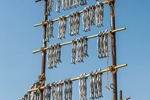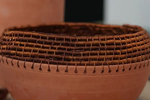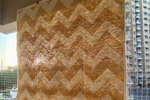
This two-part showcase brings together the Sustaina fellows Debasmita Ghosh and Poludas Nagendra Satish, whose work engages deeply with questions of climate impact, cultural continuity, and ecological resilience.
LIVING WITH THE LAND
Debasmita Ghosh’s installation stems from months spent working closely with the Kondh community in Odisha’s Rayagada district. Her research dives into how the architecture of Kondh homes is changing, shaped by climate shifts and external influences. From mud plaster giving way to cement and terracotta tiles replaced by asbestos roofing - these changes affect the thermal comfort of home as well as reshape community life and traditions.
Through hands-on workshops with Kondh youth, Debasmita explores the push and pull between age-old practices and modern dreams. The project sparks conversations about how ancestral knowledge might be reimagined, not just preserved, to help communities stay resilient in the face of change.
REWEAVING THE ECOSYSTEM
Poludas Nagendra Satish takes us on a journey through India’s fading indigenous cotton ecosystem, where once over a thousand native varieties thrived, only a few now remain. His installation is built on deep collaborations with farmers and weavers, showcasing organic weaves, traditional tools, and the stories behind them. It’s a tribute to cotton not just as a crop, but as a cultural and ecological lifeline. As climate change and unpredictable rainfall make life harder for cotton farmers, Satish shines a light on the quiet strength of native cotton, its ability to adapt to local conditions and its potential to shape a more sustainable future.
Together, these works remind us that land and fibre aren’t just raw materials, they’re living archives of knowledge, memory, and resilience, constantly evolving between tradition and change.
Sustaina India is a climate change x art initiative by Thukral and Tagra (T&T) and the Council on Energy, Environment, and Water (CEEW) aimed at mobilising creators to integrate climate awareness and sustainability conversations into the cultural fabric of India.
















